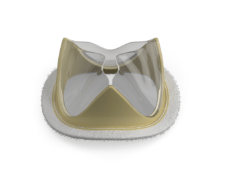Edwards Lifesciences has announced a one-year survival rate of 89.3% for high-risk patients who received the advanced Edwards Sapien 3 transcatheter aortic valve via transfemoral, as well as low rates of paravalvular leak and stroke.
The independently adjudicated data from The PARTNER II S3 trialwere presented by Howard C. Herrmann, the John Winthrop Bryfogle professor of cardiovascular diseases, and director of Penn Medicine’s Interventional Cardiology Program in the Perelman School of Medicine at the University of Pennsylvania at the 27th annual Transcatheter Cardiovascular Therapeutics meeting.
According to the one-year outcomes reported in this US FDA trial – which studied 583 high-risk and inoperable patients – Sapien 3 transcatheter aortic valve replacement (TAVR) was associated with a very low overall disabling stroke rate of 2.4%. This rate is lower than this patient population’s general risk of stroke.
There were zero patients with severe paravalvular leak and only 2.7% with moderate paravalvular leak. Furthermore, for patients with mild or less paravalvular leak, there was no association with increased mortality. There was no evidence of clinical valve thrombosis or structural valve deterioration in these patients.
“These excellent results with the Sapien 3 valve support the use of TAVR as the preferred therapy for patients at high or greater risk for surgical aortic valve replacement,” says Herrmann. “The combination of new design features of the Sapien 3 valve, procedural improvements, operator experience and improved patient selection have all contributed to strikingly low rates of one-year mortality, as well as other important adverse events, including stroke, in high-risk and inoperable patients with severe aortic stenosis.”
The Sapien 3 study is a single-arm, non-randomised cohort of The PARTNER II trial. The one-year analysis documented outcomes of the first 583 patients, whose average age was over 80, treated with the Sapien 3 valve at 29 centres nationwide and concluded January 2014. Access approaches included transfemoral (n=491) and transapical/transaortic (n=92), both high-risk and inoperable, as determined by the Heart Team.
The Sapien 3 valve was approved in Europe in January 2014 and in the U.S. in June 2015 for the treatment of high-risk patients with severe aortic stenosis.
Clinical outcomes at one year from the PARTNER II High-Risk/Inoperable trial with the Sapien 3 Valve (As-Treated):
|
Clinical Outcomes |
30 Days |
1 Year |
|
All-cause mortality – % |
2.2 |
14.4 |
|
Stroke: disabling – % |
0.9 |
2.4 |
All percents cited are Kaplan-Meier estimates.













